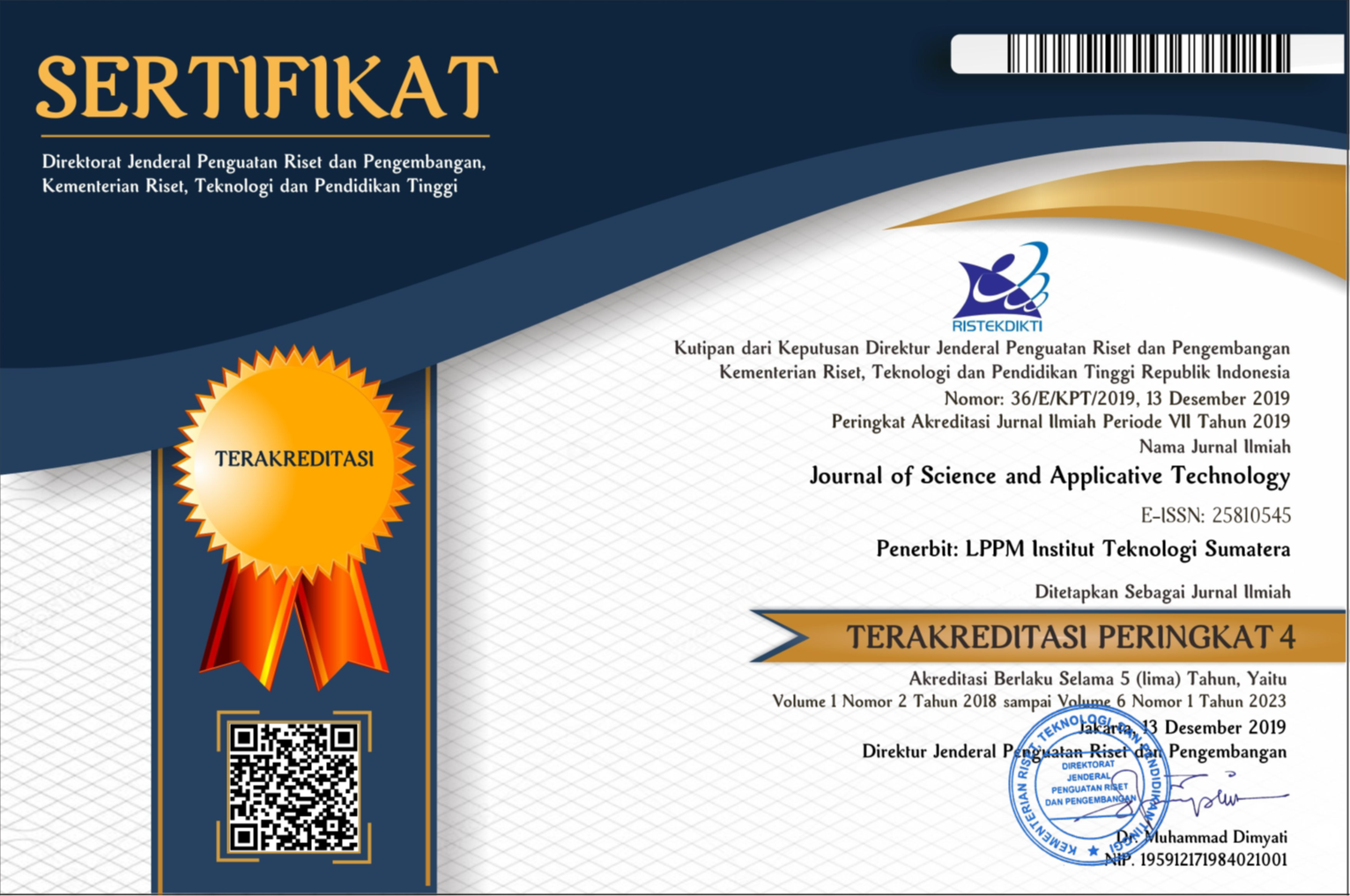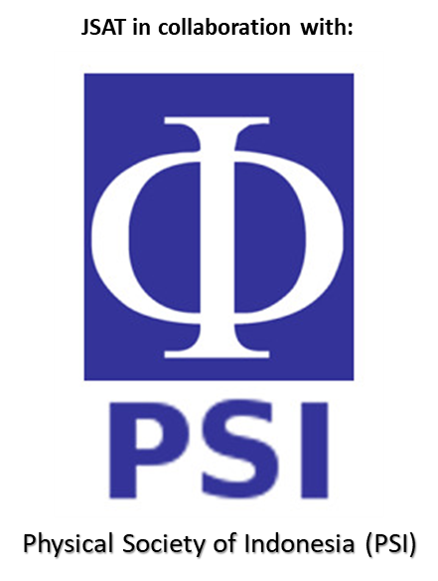Deteksi Golongan Senyawa Ekstrak Kasar Metabolit Ekstrasel Mikroalga Laut Spirulina sp. Sebagai Agen Antioksidan
Abstract
Microalgae excrete antioxidant compounds as a defense system to protect themselves from the danger of ultraviolet rays. These compounds also can be used as the organic materials of cosmetics or medicines. This study aimed to determine the antioxidant activity of marine microalgal extracellular metabolite extract of Spirulina sp.. Extracellular metabolites were extracted from the residual media filtrate from the harvesting. The qualitative antioxidant test’s results using the thin-layer chromatography technique and 2,2-diphenylpycrilhydrazil (DPPH) reagent showed antioxidant activity. Moreover, the component identification using ninhydrin and Dragendorff reagent in thin layer chromatography test showed alkaloid and peptide compounds. To support the results, the identification using infrared spectrum analysis showed the peaks at 1117 cm-1 (C-N and C-C stretching), 1458 cm-1 (C-H bending of methyl group), 1635 cm-1 (C=O stretching of amide group), and 3454 cm-1 (N-H stretching of amine and amide groups).
Downloads
References
[2] B. PoljÅ¡ak and R. Fink , “The Protective Role of Antioxidants in the Defence against ROS/RNS-Mediated Environmental Pollutionâ€, Hindawi: Oxidative Medicine and Cellular Longevity Volume, 2014.
[3] J. F. Lesgards, P. Durand, M. Lassarre, P. Stocker, G. Lesgards, A. Lanteaume, M. Prost, and M. P. L. Michel, “Assessment of Lifestyle Effects on the Overall Antioxidant Capacity of Healthy Subjects,†Environmental Health Perspectives, Vol. 110, No. 5,pp. 479-486, May 2002.
[4] J. Harasym, R. Oledzki, “Effect of fruit and vegetable antioxidants on total antioxidant capacity of blood plasmaâ€, Nutrition, Vol. 30, pp. 511-517, 2014.
[5] S. Arshiya , “The Antioxidant Effect of Certain Fruits: - A Review ,†J. Pharm. Sci. & Res., Vol.5(12), pp. 265- 268, 2013.
[6] N. Ravimanan and A. Ninsasala, “Study on antioxidant activity in fruits and vegetables – A Review,†Int. J. Adv. Res. Biol. Sci. Vol. 4, No. 3, pp. 93-101, 2017.
[7] G. A. Nayik and A. Gull, Ed., Antioxidants in Fruits: Properties and Health Benefits. Singapore: Springer, 2020.
[8] R. Singh, P. Parivar, M. Singh, A. Bajguz, J. Kumar, S. Singh, V. P. Singh, and S. M. Prasad, “Uncovering Potential Applications of Cyanobacteria and Algal Metabolites in Biology, Agriculture and Medicine: Current Status and Future Prospectsâ€, Front. Microbiol., Vol. 8, No. 515, pp1-37, April 2017.
[9] E. Shannon and N. Abu-Ghannam, “Antibacterial Derivatives of Marine Algae: An Overview of Pharmacological Mechanisms and Applicationsâ€, Mar. Drugs, Vol. 14 No. 81, pp. 1-23, 2016.
[10] K. A. M. Andrade, C. Lauritano, G. Romano and A. Ianora, “Marine Microalgae with Anti-Cancer Propertiesâ€, Mar. Drugs, Vol. 16, 165, pp 1-17, 2018.
[11] M. C. Barbalace, M. Malaguti, L. Giusti , A. Lucacchini , S. Hrelia, and C. Angeloni, “Anti-Inflammatory Activities of Marine Algae in Neurodegenerative Diseases, Int. J. Mol. Sci., Vol. 20, 3061, pp. 1-20, 2019.
[12] A. Hemalatha, K. Girija, C. Parthiban, C. Saranya, and P. Anantharaman, “Antioxidant properties and total phenolic content of a marine diatom, Navicula clavata and green microalgae, Chlorella marina and Dunaliella salina,†Adv. Appl. Sci. Res., Vol. 4(5), pp. 151-157, 2013.
[13] M.P. Rajishamol, S. Lekshmi, K. C. Vijayalakshmy, and A.V. Saramma, “Antioxidant activity of Cyanobacteria isolated from Cochin estuary,†Indian Journal of Geo-Marine Sciences, vol. 45(8), pp. 974-977, 2016.
[14] C. Sansone and C. Brunet, Marine Algal Antioxidants, Antioxidants, Vol. 9, No. 206, pp 1-4, 2020.
[15] L. Liu, G. Pohnert, and D. Wei, â€Extracellular Metabolites from Industrial Microalgae and Their Biotechnological Potentialâ€, Mar. Drugs, Vol. 14, 191, 2016.
[16] A. Latifi, M. Ruiz, & C. C. Zhang, “Oxidative stress in cyanobacteriaâ€, FEMS Microbiol Rev., Vol. 33, pp. 258–278, 2009.
[17] M. Mitterer-Daltoé, J. Bordim , C. Lise , L. Breda, M. Casagrande, V. Lima, “Consumer awareness of food antioxidants. Synthetic vs. Naturalâ€, Food Sci. Technol, 2020, (online). Available on https://doi.org/10.1590/fst.15120.
[18] C. Caleja, L. Barros, A. L. Antonio, M. Beatriz, P. P. Oliveira, and I.C.F.R. Ferreira, “A comparative study between natural and synthetic antioxidants:Evaluation of their performance after incorporation into biscuits, Food Chemistry, Vol. 216, pp. 342–346, 2017.
[19] M. Carocho, M. F. Barreiro, P. Morales, and I. C. F. R. Ferreira, “Adding Molecules to Food, Pros and Cons: A Review on Synthetic and Natural Food Additivesâ€, ComprehensiveReviews inFood Scienceand Food Safety, Vol.13, pp. 377-399, 2014.
[20] F. Y. A. Sari, I. M. A. Suryajaya, dan Hadiyanto, “Kultivasi Mikroalga Spirulina Platensis Dalam Media Pome Dengan Variasi Konsentrasi Pome Dan Komposisi Jumlah Nutrienâ€, Jurnal Teknologi Kimia dan Industri, Vol. 1, hal. 487-494, 2012.
[21] A. Vonshak, Spirulina Platensis (Arthrospira) : Physiology, Cell-Biology and Biotechnology. Taylor and Francis e-library, 2002.
[22] L. A. Martin-Visscher, M. J. V. Belkum, S. G. Tsodikova, R. M. Whittal, J. Zheng, L. M. McMullen, and J. C. Vederas, “Isolation and Characterization of Carnocyclin A, a Novel Circular Bacteriocin Produced by Carnobacterium maltaromaticum Ual30â€, Applied And Environmental Microbiology, Vol. 74, No. 15, pp. 4756–4763, 2008.
[23] J. Wang, Y. D. Yue, F. Tang and J. Sun, “TLC Screening for Antioxidant Activity of Extracts from Fifteen Bamboo Species and Identification of Antioxidant Flavone Glycosides from Leaves of Bambusa. textilis McClureâ€, Molecules, Vol. 17, pp. 12297-12311, 2012.
[24] H. Hadiyanto, M. Christwardana, and D. Soetrisnanto, “Phytoremediation of Palm Oil Effluent Mill (POME) by Using Aquatic Plants and Microalgae for Biomass Productionâ€, J. Env. Science and Technology, Vol. 6 (2), pp. 79-90 , 2013.
[25] M. Silva, L. Castellanos, and M. Ottens, “Capture and Purification of Polyphenols Using Functionalized Hydrophobic Resinsâ€, Ind. Eng. Chem. Res., Vol. 57, pp. 5359−5369, 2018.
[26] R.M. Silverstein, F.X. Webster, and D.J. Kiemle, Spectrometric Identification Of Organic Compounds. 7th edition. New York: John Wiley & Sons, Inc., 2005.
[27] S. Bhatia, A. Garg, K. Sharma, S. Kumar, A. Sharma, and A. P. Purohit, “Mycosporine and mycosporine-like amino acids: A paramount tool against ultra violet irradiationâ€, Pharmacogn Rev., Vol. 5, pp. 138–146, December 2011.
[28] D. M. Hartnell, I. J. Chapman, N. G. H. Taylor, G. F. Esteban, A. D. Turner, and D. l J. Franklin, “Cyanobacterial Abundance and Microcystin Profiles in Two Southern British Lakes: The Importance of Abiotic and Biotic Interactionsâ€, Toxins, Vol. 12:503, 2020.
[29] K. P. Lawrence, P. F. Long, and A. R. Young, “Mycosporine-Like Amino Acids for Skin Photoprotectionâ€, Current Medicinal Chemistry, Vol. 24, pp. 1-16, 2017.
[30] E. Chrapusta, A. Kaminski , K. Duchnik, B. Bober, M. Adamski, and J. Bialczyk, “Mycosporine-Like Amino Acids: Potential Health and Beauty Ingredientsâ€, Mar. Drugs, Vol. 15, 326, 2017.
[31] I. Syaichurrozi dan Jayanudin, “potensi limbah cair tahu sebagai media tumbuh spirulina platensis,†Jurnal Integrasi Proses, Vol. 6, hal. 64-68, Desember 2016.
Copyright (c) 2021 Journal of Science and Applicative Technology

This work is licensed under a Creative Commons Attribution-NonCommercial 4.0 International License.
All the content on Journal of Science and Applicative Technology (JSAT) may be used under the terms of the Creative Commons Attribution-NonCommercial 4.0 International License.
You are free to:
- Share - copy and redistribute the material in any medium or format
- Adapt - remix, transform, and build upon the material
Under the following terms:
- Attribution - You must give appropriate credit, provide a link to the license, and indicate if changes were made. You may do so in any reasonable manner, but not in any way that suggests the licensor endorses you or your use.
- NonCommercial - You may not use the material for commercial purposes.
- No additional restrictions - You may not apply legal terms or technological measures that legally restrict others from doing anything the license permits.





















